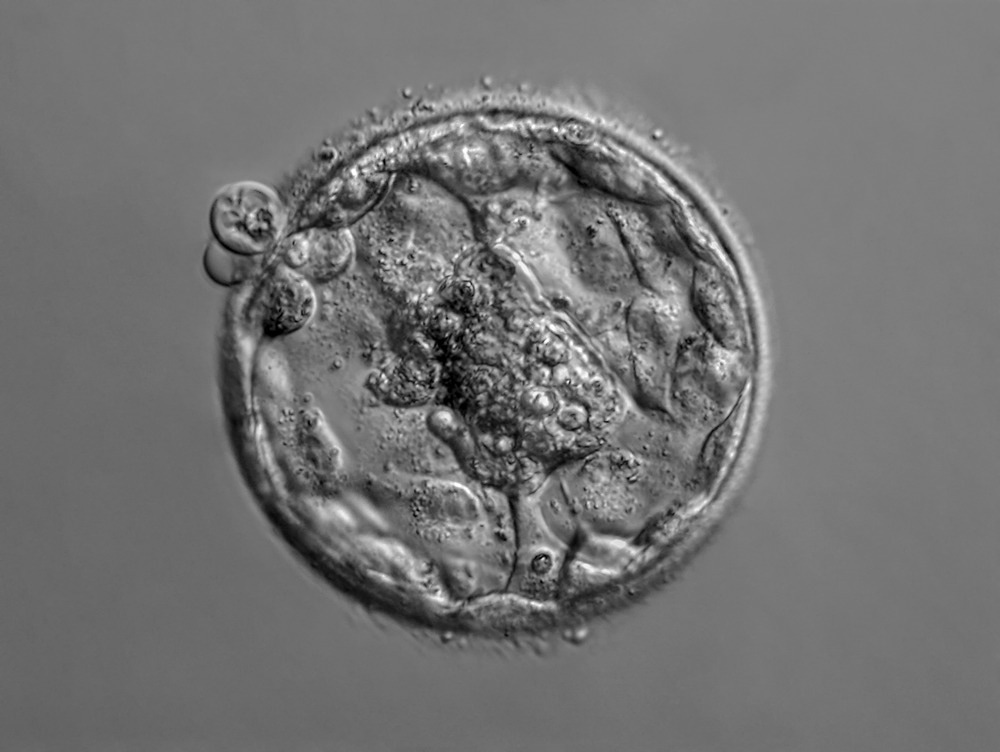Synthetic human embryology is an emerging field in which different aspects of human embryo development are recreated and studied in the in vitro setting. Synthetic human embryology integrates stem cell and developmental biology to determine human embryology. It involves merging bioengineering technologies and computational modeling to quantitatively control an in vitro developmental niche to recreate the developmental patterning observed by computer modeling (in silico).

Image Credit: Vladimir Staykov/Shutterstock.com
Synthetic embryology enables an understanding of how regulatory processes are coupled to systemic characteristics, including embryonic geometry, patterning, and inter-cell interactions. It has enabled researchers to dissect mechanisms from the micro to macro scale and understand their interactions by manipulating genes, signals, and morphology. The ability to do this is limited in mammalian experimental embryology as the conceptus at implantation is inaccessible and needs to be examined at this stage as it is when many of these important events occur.
Synthetic embryology enables the formation of embryo-like structures called stembryos which use stem cells taken from embryos. It places these cells in both near-native and novel contexts and examines the consequences as seen in the patterning and morphogenesis of cells as a result. There has been a recent explosion of stembryo model diversity.
Reconstitution Versus Reconstruction in Synthetic Embryology
The objectives in synthetic embryology can be clustered into two classes: reconstruction and reconstitution.
Reconstitution concerns the aim of building a stembryo that reconstitutes the processes that occur in early embryogenesis. This is desirable as several challenges are associated with examining the process of embryogenesis in human models. There is a significant potential associated with a reliable and controllable model that can be grown en masse.
In reconstruction, cells are cultured in contexts or combinations that differ from natural embryogenesis to decipher the underlying mechanisms. This has been used to determine genetic circuits, to investigate the outcomes on stem cells when cultured in alternative geometries (2D gastruloids made using micropatterned colonies), and/ or in the absence of principal extra-embryonic tissues (3D gastruloids). This is helping researchers to understand the design principles of multicellular development.
The possible morphological iterations depend on culture conditions despite being centered in pluripotent stem cells and their progeny. Therefore, the broad outcomes possible with stembryos make cross-comparisons of models essential in accurately defining how the underlying principles operate. For example, the natural mammalian embryo has anterior visceral endoderm (mice) or hypoblast (humans), which is thought to direct the position of cells – stembryos lack an analogous synthetic model.
However, this patterning varies dramatically with 2D gastruloids resulting in differential gene expression occurring in concentric rings – versus the breaking of symmetry to specify nascent mesoderm that occurs in 3D gastruloids. Models, therefore, can provide an insight into a common developmental landscape, as a comparison of alternative cell fates can provide the building blocks of development.
Factors to Consider in Synthetic Embryology
Studies have revealed that cells need additional environmental factors to be able to correctly simulate fate decisions and morphogenesis so that it recapitulates the embryo-like formation of the developmental landscape. Therefore, culture platforms that can accurately mimic the microenvironment are key, i.e., growing stem cells in biomimetic gels or using microfluidic environments to establish morphogen gradients essential in embryonic pattern formation.
Synthetic embryos result in cell mixing at random; this is a problem as in vivo embryonic development proceeds sequentially, ensuring that each cell type is organized in the correct configurations to facilitate intercellular signaling for pattern formation. To overcome this, the use of 3D printing can allow the stem cells to be guided toward the starting conditions of the appropriate self-organization pathway.
Intrinsic and Extrinsic Factors Affecting Development
Development is also regulated by intrinsic and extrinsic control: intrinsic control shapes the landscape's topography; extrinsic control bias is how the developmental trajectory is played out. Extrinsic control can be manifest as boundary conditions, as seen in germ layer patterning in 2D gastruloids.
Synthetic embryology allows stem cells to be cultured in alternative environments and configurations. This allows a common landscape of the embryo's development at its early stage to be determined. This landscape is affected by intrinsic mechanisms that cause self-organization and external factors that influence directionality and inter-cell communication. Synthetic embryology used for reconstitution demonstrates the conditions that allow synthetic embryos to mimic natural development as closely as possible. In the context of reconstruction, synthetic embryology allows the exploration of development as a whole and is experimental, allowing the analysis of stem cells in alternative configurations and combinations.
Sources:
- Cornwall-Scoones J, Zernicka-Goetz M. (2021) Unifying synthetic embryology. doi:10.1016/j.ydbio.2021.03.007.
- Ghimire S, Mantziou V, Moris N, et al. (2021) Human gastrulation: The embryo and its models. Dev Biol. doi: 10.1016/j.ydbio.2021.01.006.
- Harrison SE, Sozen B, Christodoulou N, et al. (2017) Assembly of embryonic and extra-embryonic stem cells to mimic embryogenesis in vitro. Science. Doi: 10.1126/science.aal1810.
- Sozen B, Cornwall-Scoones J, Zernicka-Goetz M. (2021) The dynamics of morphogenesis in stem cell-based embryology: Novel insights for symmetry breaking. Dev Biol. doi: 10.1016/j.ydbio.2020.12.005.
- Todhunter ME, Jee NY, Hughes AJ, et al. (2015) Programmed synthesis of three-dimensional tissues. Nat Methods. doi:10.1038/nmeth.3553
Further Reading